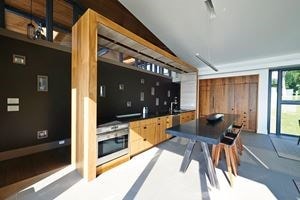Steven Comisso

Lynch + Comisso: Architecture + Light
-
READ MORE ABOUT STEVEN
-
Steven Comisso, a founding partner with Lynch + Comisso: Architecture + Light, has expertise in planning, conceptual design and detailing. The scope and scale of projects he is involved with has increased steadily. He was the Architect and project lead for the $3.2M Aurora Heritage Centre completed in 2010, in addition to recently completed lobby renovations at the Varley Art Gallery in Markham. Steven began his architectural career in New York City in 1992 where he worked at a number of firms covering all manner of architectural services. This included retail and high-end interior design firms where he mastered millwork design and detailing. On his return to Toronto, he focused on residential and retail work building on his experiences in New York. Having recently completed the final structure on an estate on Lake Simcoe, he is currently working on an event space within a heritage barn at the Markham Museum, as well as a rural event space in Beaver Valley, Ontario.
Q&A with Steven Comisso
How do you approach the design process?
I often look at the context. In our current entry, there are cues in the steel structure of the boathouse that we expand on. In its former life the boathouse slip was also a workspace to maintain the vessels that were housed there. In our kitchen design we have a trestle table that is our work surface; only now it is for entertaining. Lighting also figures prominently in my designs because the kitchen can either be centre stage or in the supporting cast depending on the wishes of the client.How does your aesthetic stand out amongst other designers/architects?
I am open to using materials in non-traditional ways. I see beauty in raw materials and use that in my designs. In reference to kitchens I weave the cabinetry into the flow of the room. This frees up the visual landscape so I can place the design emphasis where it is needed.What is the greatest value you provide your client?
I involve them in the design. They enjoy being part of the creative process, and their contributions are often more valuable to a project than you could have envisioned at the outset. The good ones push you and allow you the latitude to be better than good – even great.What is your biggest challenge as a designer/architect?
In the kitchen, my biggest design challenge is always the refrigerator. It seems mundane but it is very important to integrate it in such a way so as not to overpower or anchor the kitchen in a negative way.What are some of the current design trends?
I see a lot of raw and reclaimed materials and vintage looks coming up. Visual frames are important now; they set up the focal point of the kitchen and help to visually organize the different elements.Where do you see kitchen design going in the next 5 years?
I see two streams evolving: one automates the kitchen function and the other is back-to-basics. They are at complete opposite ends of the spectrum. In many kitchens, we are seeing more and more highly specialized devices (witness the proliferation of the soda stream), which must be accommodated as part of the flow of the food preparation process in the kitchen. At the other end of the spectrum, the foodies (people who love food and cooking) love simplicity which means fewer gadgets and machines and only the essentials are needed in the kitchen.
-



